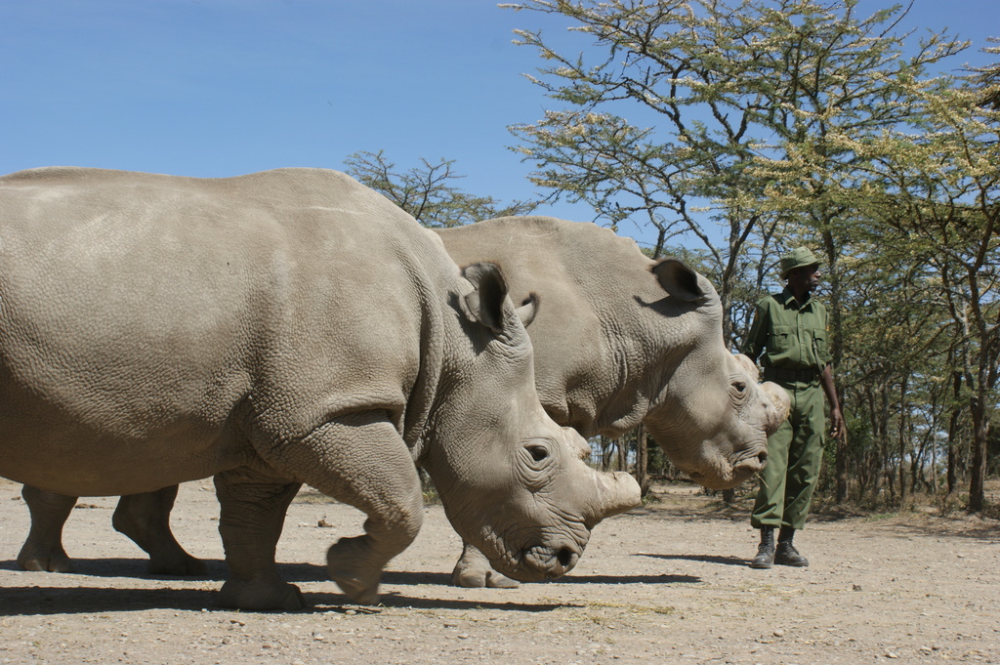In the vast savannas of Africa, among the golden grasses and under the expansive skies, once roamed one of the most magnificent creatures on Earth—the Northern White Rhinoceros (Ceratotherium simum cottoni). However, today, this majestic species teeters on the brink of extinction, a tragic victim of human greed, habitat loss, and senseless violence.
A Species on the Brink
The was once abundant across the grasslands of central Africa, ranging from Uganda, South Sudan, the Central African Republic, and the Democratic Republic of the Congo. However, relentless poaching for their valuable horns, compounded by habitat destruction and civil unrest in their native regions, has led to a catastrophic decline in their population.
As of 2022, only two individuals remained—both females named Najin and Fatu—both under constant surveillance and protection in Ol Pejeta Conservancy in Kenya. The last male, Sudan, passed away in 2018, marking the end of the hopes for natural reproduction within the species.

The Horned Tragedy
The primary driver of the Northern White Rhinoceros’s decline has been the insatiable demand for its horn. Despite being composed of keratin, the same substance as human hair and nails, rhino horn is erroneously believed in some cultures to possess medicinal properties and is also highly prized as a status symbol.
This demand has fueled a relentless and often brutal poaching industry. Rhinos are targeted by heavily armed poachers who hunt them down mercilessly, often leaving behind orphaned calves and traumatized herds. The lucrative illegal trade in rhino horn continues to thrive, with prices on the black market surpassing that of gold or cocaine.
Conservation Efforts and Challenges
Efforts to save the Northern White Rhinoceros have been valiant but fraught with challenges. Conservation organizations, governments, and local communities have rallied together to protect the last remaining individuals, employing sophisticated technology such as drones, GPS tracking, and armed patrols to safeguard them from poachers.
Furthermore, innovative reproductive technologies, including in vitro fertilization (IVF) and surrogacy, offer a glimmer of hope for the species. Scientists have collected and preserved genetic material from deceased Northern White Rhinos, with the aim of one day using it to artificially inseminate Southern White Rhinoceros females or even create hybrid embryos using closely related species such as the Southern White Rhinoceros.
However, these efforts face significant hurdles, including logistical challenges, financial constraints, and the inherent complexity of reproductive biology. Moreover, the loss of genetic diversity within the Northern White Rhinoceros population poses a serious threat to the long-term viability of any potential conservation breeding program.
Beyond the Brink: Lessons Learned
The plight of the Northern White Rhinoceros serves as a poignant reminder of the urgent need for concerted global action to conserve Earth’s precious biodiversity. It highlights the devastating impact of human activities on vulnerable species and ecosystems and underscores the moral imperative to protect and preserve our natural heritage for future generations.
Furthermore, it underscores the interconnectedness of environmental conservation, sustainable development, and social justice. The same factors driving the decline of the Northern White Rhinoceros—poverty, conflict, and lack of alternative livelihoods—also contribute to broader environmental degradation and human suffering.
A Call to Action
In the face of such daunting challenges, it is easy to feel overwhelmed or despondent. However, there is still hope. The story of the Northern White Rhinoceros is not yet over, and there are concrete actions that each and every one of us can take to make a difference.
First and foremost, we must combat the illegal wildlife trade by strengthening law enforcement, reducing demand for wildlife products, and supporting sustainable livelihoods for local communities. We must also invest in habitat protection and restoration, ensuring that wild spaces remain intact for future generations of rhinos and other species.
Additionally, we must advocate for policies that promote conservation and sustainable development, both at the national and international levels. This includes supporting initiatives to combat climate change, which poses a grave threat to rhino habitats and biodiversity more broadly.
Conclusion
The plight of the Northern White Rhinoceros is a stark reminder of the fragility of life on Earth and the profound impact of human actions on the natural world. However, it is also a testament to the resilience of nature and the power of collective action.
By working together to address the root causes of biodiversity loss and climate change, we can ensure a brighter future for not only the Northern White Rhinoceros but for all life on Earth. It is up to us to heed the call of nature and rise to the challenge of conservation, for the sake of this magnificent species and for generations to come.









